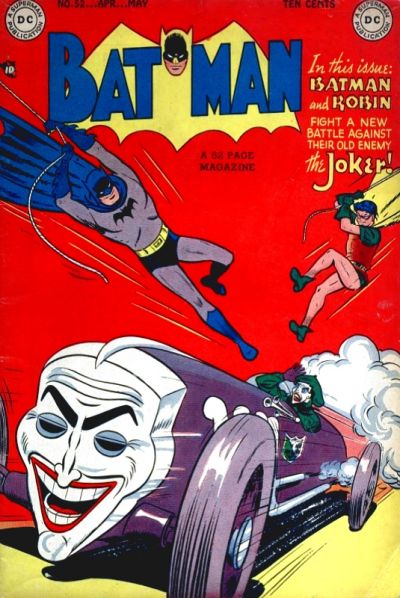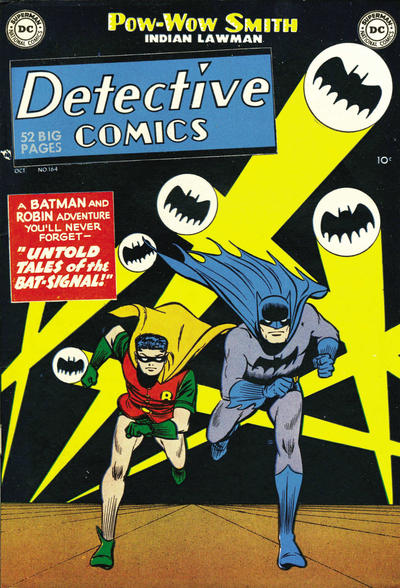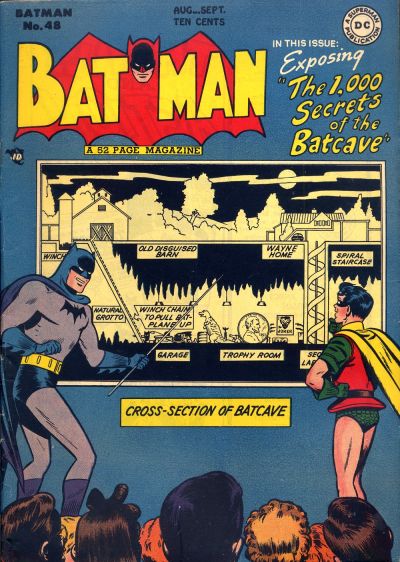Shining the Batsignal on one of Gotham’s forgotten heroes …

—
UPDATED 5/1/18: I first posted this two years ago and I set about doing another version but the thing is, I love these covers. Love them. So even though Mortimer did a lot more than this, I’m sticking with these one more time. — Dan
—
History loves shorthand, especially comics history.
People with short memories or a thin grounding in the Bronze Age think Denny O’Neil and Neal Adams single-handedly returned Batman to his darker roots — often forgetting names like Frank Robbins or Len Wein or Irv Novick or Bob Brown or Mike Friedrich.
The Silver Age was all Carmine Infantino, right? Well, not exactly.
And so it goes all the way back to the Golden Age. When you talk Batman before the mid-’50s, fans frequently refer to the “Jerry Robinson look” or the the “Dick Sprang style.” Thing is, there were so many others whose names just never stuck to the tongue, like Fred Ray or Jim Mooney or George Roussos or, in this case, Win Mortimer.
Mortimer, who was born May 1, 1919, produced not only some of my personal favorite Batman covers, he produced some of the most famous and iconic Batman covers ever. He died in 1998 but he quietly left an indelible mark on Gotham.
This is a 13 COVERS salute I’ve been waiting to do, because just check out these beauties. Mortimer penciled and inked them all, with one exception.
Feast your eyes:

I own this one. Love it, love it, love it.

The first Riddler appearance.

George Roussos inks. Own this one too. One of the most beautiful covers ever.










—
Cover images and credits from the winning Grand Comics Database.

May 1, 2016
GREAT selection of covers, Dan! FYI, I delivered this at Win’s funeral in 1998:
Eulogy for WIN MORTIMER by Arlen Schumer
Win Mortimer died January 10, 1998 from bone cancer. He was 78 years old.
I worked with Win at Neal Adams’ Continuity Associates from 1983-85, pencilling storyboards and comp art (that Neal would ink and then have colored) for advertising agencies. Win worked in a room with fellow DC Comics old-timer Jack Sparling. Sparling’s work was still fresh in my mind then, because I was a big fan of his 1968 series Secret Six, “Johnny Double” in Showcase, and a couple of post-Adams Spectre stories. But Mortimer’s background was more of a mystery to me; I couldn’t recall anything he had particularly done, though I somehow knew he was an old-time DC artist, as if his name had seeped into the part of my brain that stores comic book history.
But the more I saw of his pencilling, I realized he had drawn one of my favorite comics from my childhood, a pre-TV show Batman Brave & Bold, the team-up with Eclipso, issue #64, March ‘66 (with a great cover by Gil Kane!). From that moment on, I felt a kinship with Win, an eccentric little man with a big heart and great sense of humor—and took more interest in his artwork.
I noticed that, although his present drawing style seemed a little quaint and wispy for Adams’ inking needs (then again, everyone’s pencilling seemed quaint and wispy compared to Adams’!), Neal always gave Win the most complicated storyboards to draw, the comps with the most people in them, the crowd scenes, difficult backgrounds requiring strong perspective. And Win always came through—and on time!
I left Continuity in ‘86, but at least once or twice a year I’d stop up at the offices on West 45th Street in Manhattan to say hello. Invariably the cast of younger artists would be different, but Win was the constant, drawing away at his board that he kept propped up more like a painting easel, using pencils that he hand-sharpened on a graphite stone. He never wanted to retire, and Neal never stopped giving him the tough drawing assignments.
I always wondered: why Win? Why, when Adams could have had any hotshot young artist drawing for him, considering the wealth of talent that had passed through Continuity’s doors over the years, did he keep this man commuting every day from Carmel in upstate New York?
A few years ago, I finally found out why. Around 1993, Abbeville Press published those miniature (4-inch square) books, Superman in Action Comics and Batman in Detective Comics, both featuring, in chronological order, the covers of the first 25 years. Inside was the work of all the well-known artists associated with those titles: Shuster, Boring, Plastino and Swan in the Superman book, Kane, Robinson, Sprang and Moldoff in Batman.
But the revelation in those books was the incredible covers by Win Mortimer. While most of the artists of that era favored a bold, pin-up approach that focussed on the foreground figures, Mortimer’s covers were all beautifully-detailed gems, complete scenes with full backgrounds and dynamic perspectives. Mortimer was an avid collector of antique guns and cars—he had a working Model-T Ford—so all the covers that featured period props like stagecoaches and classical foreign cityscapes were invariably done by him.
And the sheer, staggering amount of covers Mortimer drew! More than Boring and Sprang! So many of the covers I had seen as a child reproduced on the covers of the Superman and Batman 80-page Giants and Annuals were by Mortimer! As I flipped page after page of those mini-books (and then their larger, hardcover editions published subsequently), it dawned on me that Winslow J. Mortimer was the de facto cover artist for DC Comics’ two flagship characters for almost ten years straddling the 1940’s and 50’s!
And that was the era that a young Neal Adams grew up in, reading DC Comics. Adams must have been influenced by those great Mortimer covers, and that is why, I suppose, he had a deep respect for Win’s work; Adams never forgot that Win could compose a great drawing on paper, featuring people, places and things expertly drawn.
Thanks to those books, I believe Win achieved a kind of revisionist respect for his work in the comic book field. He was to be a guest of honor at last year’s San Diego ComiCon, but could not attend due to his failing health (my one true regret now is that his story, in his words, was not properly documented, so yet another great chapter of comic book art history dies along with him). But at least he lived long enough to know that he was esteemed by the industry he had toiled in for so long. And that we, the collectors and lovers of the great medium of comic book art will always have the beautiful work of Win Mortimer to study and enjoy forever.
May 3, 2023
It’s many years later, I know, but thank you for posting your eulogy. You’re right about those Abbeville books. That’s how I became acquainted with (and fell in love with) Win Mortimer’s art.